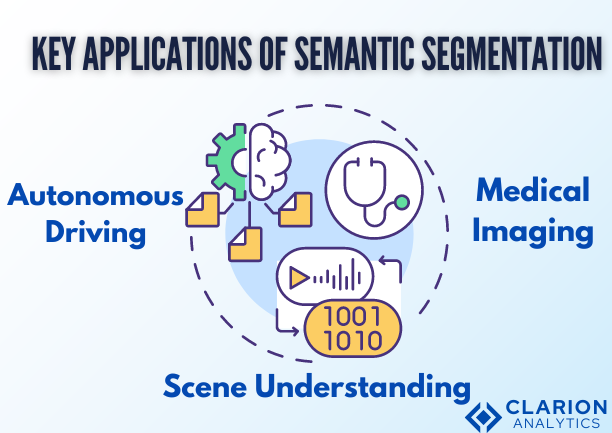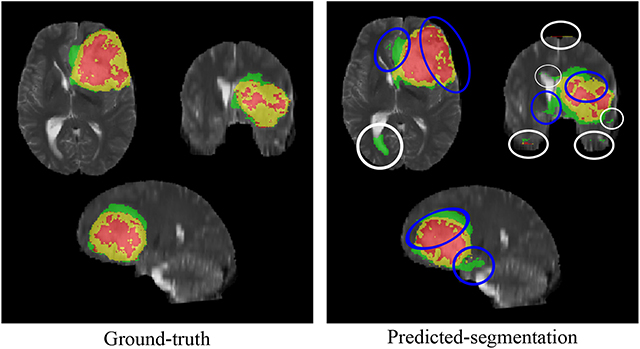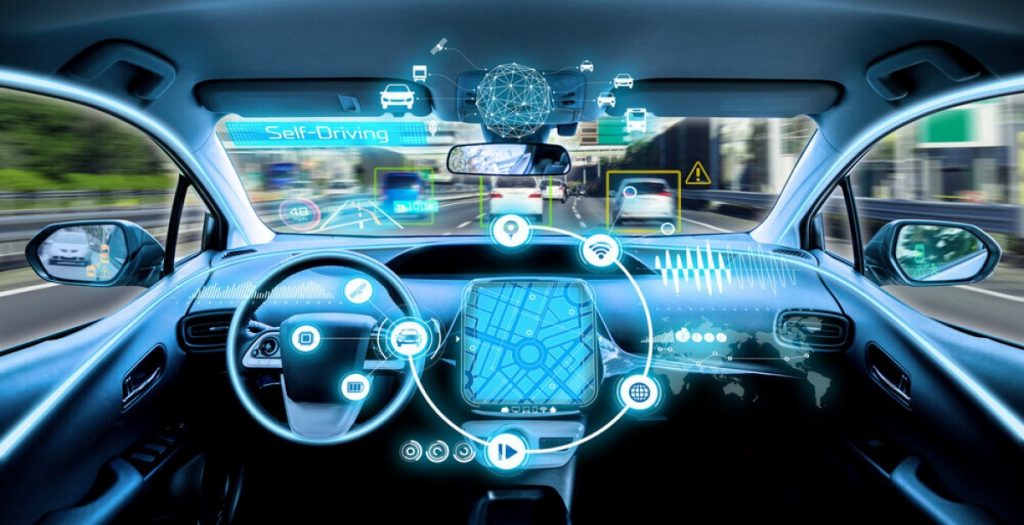
Computer vision requires semantic segmentation as its fundamental task to convert image pixels into particular categories. The prediction at pixel level enables computers to understand visual content with greater accuracy and finds essential use in applications including autonomous driving and medical imaging alongside scene understanding. The advancement of deep learning drives semantic segmentation advancement which brings both novel opportunities along with new complex issues for developers to overcome. Software developers and CXOs must engage with emerging trends since industries with growing computer vision technology dependence need competitive software solutions in order to succeed.
Understanding Semantic Segmentation
The method of semantic segmentation requires computers to assign each image pixel with a particular class or label. The method surpasses object detection by performing object boundary definition at pixel accuracy. The technique serves as an essential tool for computer vision because it delivers precise scene interpretation and powers different applications such as medical analysis and autonomous vehicle systems.
Key Applications of Semantic Segmentation
Several industries depend on semantic segmentation for their operations.
The interpretation of self-driving car surroundings depends on segmentation since this process detects and classifies roads with pedestrians and vehicles together with obstacles to ensure vehicle safety during navigation.
The healthcare field uses semantic segmentation to separate organs tissues and tumors in medical imaging scans which benefits medical diagnosis together with treatment management.
Machines gain better understanding of their surroundings by using semantic segmentation which enables more efficient and dependable operation of robotics and augmented reality technologies.

The Evolution of Semantic Segmentation Techniques
Deep learning has brought substantial progress to semantic segmentation throughout its historical development. Before CNNs appeared the field operated using handcrafted features together with classical machine learning models until CNNs transformed image processing. The field of semantic segmentation made two essential breakthroughs through Fully Convolutional Networks (FCNs) for pixel-level predictions followed by U-Net and DeepLab for accuracy improvements. Recent developments in transformer-based models have produced new perspectives for both enhancing performance along with reducing costs in this field.
Emerging Trends in Semantic Segmentation
1.Advanced Deep Learning Architectures
a)Transformer-Based Models
Transformers which were developed for natural language processing created substantial improvements in computer vision especially in the field of semantic segmentation. By using Vision transformers (ViTs) together with their derivatives like Swin Transformer users can achieve superior image segmentation in complex visual content through their ability to understand extended visual relationships. The self-attention mechanisms present in transformers help them perform better than CNNs at understanding global context especially across big-scale datasets.
b) EfficientNet and Beyond
The semantic segmentation structure benefited from EfficientNet because this model optimizes how parameters are used when balancing accuracy with model size. EfficientNet-based segmentation models deliver excellent performance using less computational power so they become optimal for usage across mobile devices coupled with edge computing platforms. The models employ compound scaling to simultaneously modify their depth as well as width and resolution parameters for enhanced accuracy and efficiency.
c) Integration of Multi-Modal Data
Additional performance gains from semantic segmentation models emerge from combining RGB images together with depth or thermal data. Autonomous driving systems that combine RGB imaging with LiDAR data produce superior depth perception along with better object identification which leads to enhanced accuracy in complex road conditions. The medical imaging field shows increasing interest in multi-modal fusion which enables more complete anatomical structure segmentation by unifying different imaging modalities (such as MRI with CT scans).
2.Real-Time Semantic Segmentation
Real-time semantic segmentation represents a critical requirement for autonomous driving and robotics applications since decisions need to happen within milliseconds. Model pruning as well as quantization techniques and lightweight architectures including MobileNet and ENet help semantic segmentation models achieve high accuracy alongside efficient edge operations. Model and hardware optimization initiatives enable real-time segmentation to be practical for implementation in situations that demand rapid processing.
3.Self-Supervised Learning Approaches
The adoption of self-supervised learning methods enables semantic segmentation by making it possible to operate without big labeled datasets that demand both significant time and financial resources for creation. Self-supervised learning methods extract valuable representations from untagged information that afterwards accepts fine-tuning using minimal labeled datasets. This field starts to adopt contrastive learning and masked image modeling techniques because these methods result in high performance while operating with minimal labeled data.

Techniques and Tools for Enhanced Performance
1.Data Augmentation Strategies
a) Synthetic Data Generation
Using synthetic data generation delivers a robust solutions to extend training datasets especially when dealing with limited or complex annotation tasks. The combination of GANs (generative Adversarial Networks) together with domain randomization allows managers to produce multiple realistic training examples. Autonomous driving industries utilize synthetic data as an essential training instrument to develop models for processing uncommon dangerous situations particularly severe weather events and near-accident maneuvers.
b) Domain Adaptation
Semantic segmentation models benefit from domain adaptation methods to interpret unknown environments which differ from their training database. The proposed methods resolve domain shift through their ability to prevent performance declines when models operate between different datasets. The two popular methods for domain adaptation are adversarial training which helps models reduce domain gap differences and style transfer that modifies training data appearance to match target domains.
2.Model Optimization Techniques
a)Model Compression and Pruning
Semantic segmentation models require model compression and pruning to achieve effective deployment on edge devices that maintain limited computational capabilities. Both compression techniques and pruning methods decrease model size by retaining only essential parameters in neural networks. These optimization methods lower the needed inference time and memory requirements at marginal expense to accuracy levels thus enabling real-time implementations.
b)Hyperparameter Tuning
The successful performance of semantic segmentation models depends heavily on hyperparameter tuning methods. The combination of grid search and random search together with Bayesian optimization enables users to discover the best possible training parameters. Several automated frameworks such as Optuna and Ray Tune enable researchers to reach optimal model performance by efficiently exploring the hyperparameter landscape for hyperparameter tuning.

3. Evaluation Metrics and Benchmarking
a) Common Metrics for Semantic Segmentation
Special metrics must be used to evaluate semantic segmentation models because they determine pixel-level accuracy and predictive segments compared to ground truth segments. The most common metrics include:
The criterion of Intersection over Union determines overlap measurement by performing a ratio operation on segment intersections relative to their combined areas.
The calculation of Pixel Accuracy determines the total number of appropriately identified image pixels.
Multi-class segmentation evaluation benefits from Mean IoU (mIoU) because it computes averaged Intersection over Union scores for all segmentation classes.
b) Benchmarking Datasets
Performance evaluation and comparison of semantic segmentation models relies heavily on benchmarking datasets for evaluation purposes. Some popular datasets include:
The research of autonomous driving systems makes heavy use of Cityscapes mainly dedicated to decoding urban environments.
PASCAL VOC: A general-purpose dataset for object detection and segmentation.
ADE20K serves as a diverse collection for scene parsing and segmentation across different environments.
The COCO dataset has undergone expansion into COCO-Stuff which adds pixel-level annotation data for understanding different environments.

Future Directions and Challenges
a) Upcoming Trends in Semantic Segmentation
The future direction of semantic segmentation includes three factors: transformer-based models alongside self-supervised learning and multi-modal data fusion. Future advancements in segmentation models will enhance accuracy while improving efficiency for complex real-world applications. The adoption of segmentation in edge computing and mobile applications will grow because of advancing lightweight real-time model development.
b) Challenges and Limitations
The field of semantic segmentation continues to face multiple obstacles despite major progress during the last years. The main restriction of deploying and training deep learning models exists in their substantial computation requirements especially for real-time systems. The process of reaching high performance across multiple datasets with different domains generates obstacles because models typically fail to adapt their knowledge to new environments. Self-supervised learning helps overcome this barrier by requiring only large datasets since the need for extensive human annotation continues to be a major bottleneck.
c) Ethical Considerations in Semantic Segmentation
The implementation of semantic segmentation produces ethical dilemmas that become most prominent when used inside surveillance systems and autonomous driving functions. Each segmentation model needs to be both accurate and unbiased because such qualities protect against potentially dangerous system responses like misidentification of pedestrians and other road users in autonomous vehicles. Understanding privacy needs becomes essential when developers implement segmentation tools to surveillance systems and similar sensitive applications since developers have to meet ethical requirements while pursuing technological advancements.
Conclusion
Semantic segmentation has a promising outlook because new emerging trends and methods create inventive solutions benefiting industries that span from autonomous driving to healthcare. To survive in the fast-moving computer vision space both software developers and CXOs need to follow recent progress in this field. Companies that embrace modern architectural frameworks and data transformation methods and model enhancement strategies will obtain intelligent operational systems that resolve practical issues.
Intrigued by the possibilities of AI? Let’s chat! We’d love to answer your questions and show you how AI can transform your industry. Contact Us
